Ghost Recon Breakpoint PvP guide
Dominate Ghost War with our top tips.
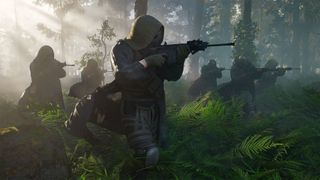
Ghost Recon Breakpoint isn’t just a sprawling open-world, single-player shooter. Making a return from Wildlands is Ghost War, a competitive player-versus-player mode that offers a different spin on the Ghost Recon formula, with plenty of rewards for those who can brave an enemy team of human players.
While it’s still recognisably Breakpoint, there are enough differences between the main game and Ghost War to throw beginners off, so here's some help to get started.
How to unlock Ghost War
Ghost War isn’t unlocked straight away. Before you can play PvP, you need to get to the Erewhon hideout, found at Twin Falls Mountain in the Mount Hodgson region. Fortunately the story forces you to go here as one of the first primary objectives in the game, meaning you’ll unlock PvP within the first 20 minutes of play.
From there there are three ways to access Ghost War. The first is through the Ghost War category in the main menu, the second is through the Objectives screen… also in the main menu. The third is by finding the NPC in Erewhon. He's found near the shop, highlighted on the map by two crossed knives.
Regardless of your method, you'll be prompted to host a custom game or initiate matchmaking. Custom games can be modified however you like, and can also be kept private if you have seven other friends ready to join you.
The format
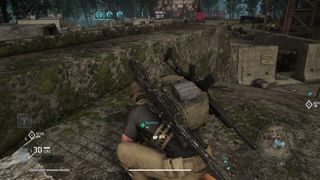
For anybody who has played The Division’s Conflict PVP mode, Ghost War feels very familiar. Two teams of four fight with the same loadouts they use in PvE, with loot balanced to ensure newcomers stand a chance against those with late-game goodies.
Ghost War has a few significant differences that give it its own Ghost Recon-flavour, though. Firstly, nobody ever outright dies: downed players can’t respawn, but can be revived at any time by a teammate. This means pulling back and sneaking around to recover your team instead of going for a clutch 1v4 victory is an entirely valid strategy.
The biggest gaming news, reviews and hardware deals
Keep up to date with the most important stories and the best deals, as picked by the PC Gamer team.
Despite the lack of death, there is a lot less health to go around compared to the armour-laden slugfests of The Division. Other players can be taken out in single headshots, and anything else only takes a few hits to take out. It’s vitally important to hang back, collect information, obscure your own position, and plan instead of blindly charging in.
Any weapons discharge can give away your location. Even with a silencer, firing will show a hotspot on the map for the other team, meaning spray-and-pray or cheap shot tactics just won’t work. Always remember to position, aim carefully, fire with purpose, and reposition to avoid being caught out.
Modes
There are only two game modes in Ghost War: Elimination and Sabotage. Both are played in 'Best of X' formats, with the default being best of three, although custom games can set different win conditions.
Elimination is a standard deathmatch. Each team must locate and take out all four enemies. This mode in particular is where the design choice to not have any player permanently taken out of the game becomes so interesting, as what initially seems like an easy victory can turn to failure if the surviving members can pick up their teammates.
Sabotage is more like Counter-Strike’s Bomb Defusal mode. One team are the attackers with the goal of planting and defending a bomb in one of two zones in the map, while the other team has to stop them. Downing the enemy team, detonating a bomb (for the attackers), or defusing it (for the defenders) secures a victory.
Communication and pinging
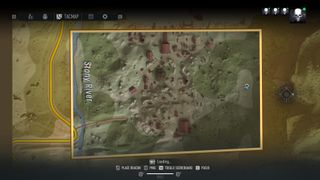
Regardless of which mode you’re playing, communication between your team is crucial. Fortunately, whether you play with a microphone or not, there are a few useful tools to help you get your point across.
The pinging system isn’t quite as advanced as in Apex Legends, but it's a handy feature. Hit the Q key to ping a location, enemy, bit of equipment, or target, and it’ll highlight it to your team. Most importantly you can ping while downed and spectating a teammate, letting you serve as a loot-focused guardian angel.
You can also ping both in-match and during the pre-game loading on the Tacmap. The Tacmap shows the entire map, letting you work out strategies, vantage points, and potential cover collaboratively with your team. Because the in-game pinging often gets caught up on walls, rocks, and scenery, if you need to convey depth (such as where a sniper is, or that an enemy is hidden behind cover), rather than just a general direction, it’s often more useful to ping through the Tacmap instead.
Drones and surveillance
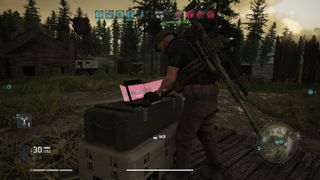
If any mechanic defines modern Ghost Recon games, it’s the drone. Take to the skies, identify enemies, keep an eye on teammates, or just be a general nuisance, drones have a lot of different applications.
In Ghost War, things are slightly different: you don’t always have a drone available to you. Instead it’s found as a power up within the map. Once activated the drone controls the same way as it always does, except you have to be much more careful of open spaces. Players are (mostly) a lot more intelligent than the AI, so getting spotted whizzing around can result in you getting sniped out of the sky before being of any use to the team.
Hide in the treeline, as from a distance the drone can be difficult to make out even once marked and move erratically to deceive snipers. Drones are fast, weak, but immensely useful for gathering intel, so make them count.
The other big way of finding the enemy team is through the Surveillance System. Each map has a central location that will activate during the match. If you’re able to capture it, every member of the enemy team will become visible for a limited time. This is particularly useful when there's a lone enemy left, as it prevents them from sneakily picking up their team, or flanking around the entire map to get the drop on you. However, it takes a while to activate the Surveillance System, making anyone who does so a sitting duck. Get a teammate to cover your flanks while doing it if possible.
Missions
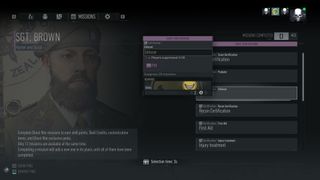
Outside of the game mode’s main goal, there are optional objectives to complete throughout Ghost War. These are generally split into Rank Up Challenges and Ghost War Missions.
As the name suggests, Rank Up Challenges allow you to progress your chosen class’ rank, and are usually actions specific to that class’ function or preferred weapon loadout. While some can be completed in both PvE and PvP, player-versus-player modes include extra challenges that can be completed only in Ghost War, such as killing enemy players with a specific type of weapon, winning a certain amount of rounds, or (at least for the Field Medic) healing teammates with the med kit. Like in PvE, ranking up your classes unlocks new abilities and cosmetics. It’s not quite as significant a reward as the Ghost War Missions, but it’s still worth keeping them in mind.
There are also larger objectives, called Ghost War Missions. These are reminiscent of Destiny 2’s Bounties: they’re not bound by which class you play, but you can only have a set number of them active at any one time. Completing them gives you plenty of rewards—like skill points and Skell credits—as well as unlocking another mission in its place. There are 43 missions at time of writing, including reviving teammates and wiping out all four enemies by yourself.
While the missions are a nice source of rewards, they’re not something you actively have to keep an eye on. You can pin the Ghost War Missions to your HUD, just like any other objective in the game, but they’ll still track and complete in the background if you don’t.
Ghost War is just one small part of Ghost Recon Breakpoint, but it’s well worth getting stuck into, nonetheless. It’s a slower, more tactical and cooperative take on Breakpoint than in PvE, and it’s also a fantastic source of skill points and fancy loot to boot.
Most Popular

